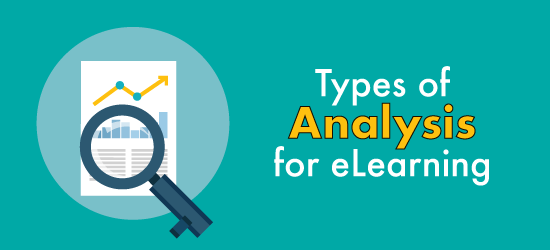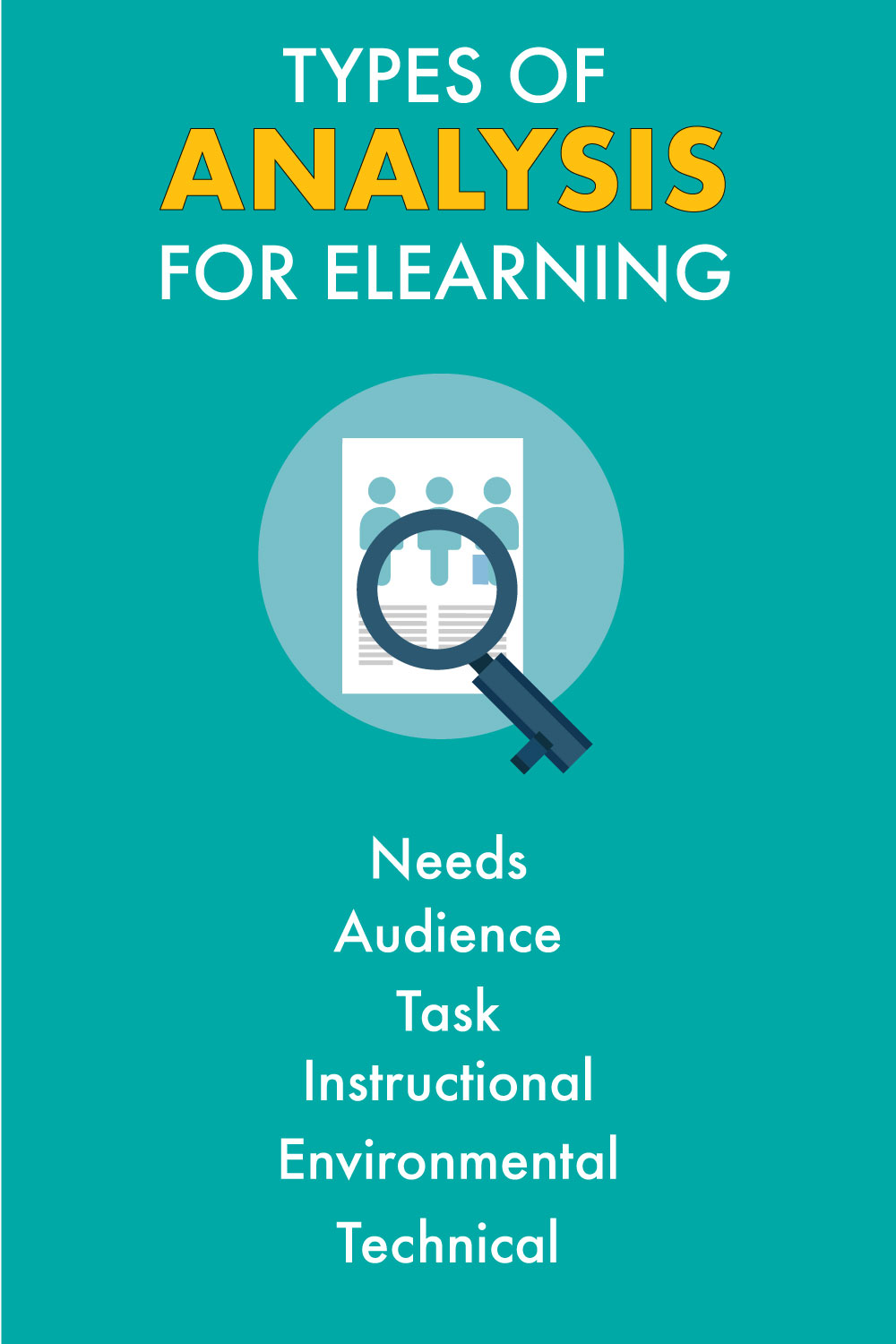
Before starting a new training initiative or even an idea for a project, you need the facts before proceeding. You can gather the facts by conducting one or more forms of analysis, of which there are many types. This article explains how to do an analysis for eLearning.
You’ll find that the amount of effort required to do an analysis for eLearning varies. In some cases, it involves no more than interviewing several key people. In other cases, an analysis might involve pouring over organizational documents or examining survey results from scores of audience members. The depth of the analysis depends on the organizational, project, and performance goals.
1. Needs Analysis
A needs assessment provides data that tells you about a difference between the current state of things and the desired future. That is, it defines the gap between the current performance of a target audience and the desired performance. A needs analysis uncovers the cause of the gap found in the needs assessment. This provides input to the type of solutions you might recommend.
At a high level, the needs analysis identifies the knowledge and skills that are missing and might also delineate workplace issues and attitudes that could affect a training initiative. It’s always helpful to gather personal stories, experiences and other forms of quantitative data.
How to get the information:
- Organizational documents (mission statements, goals, policies)
- Interviews with stakeholders and managers
- Interviews with target audience members
- Interviews with other relevant staff, e.g., Information Technology and Human Resources
- Surveys and questionnaires to the target audience to assess knowledge
- Observation of target audience members performing relevant tasks
2. Audience Analysis
The goal of an audience analysis is to help designers and developers understand their audience to serve them most effectively. The audience analysis identifies each audience group who will engage in training and the characteristics of each group.
Try to identify the following:
- Demographics (gender, age range)
- Cognitive characteristics (educational level, language, prior knowledge related to subject, computer literacy; learning preference—independent, motivated, requires assistance, etc.)
- Work characteristics (job roles, work responsibilities, work schedule)
- Affective and social characteristics (interests, attitudes and biases, what makes them laugh, what they disdain)
- Any other traits that could influence the strategies and approaches to learning you might use
- Relevant data from Learning Management System
- Business, sales, HR data (turnover rates, safety data, performance)
Although each group is composed of individuals, try to focus on the similarities within each group. After your audience analysis, you may want to see how to create learner personas. As with many forms of analysis, it’s helpful to gather personal stories, experiences and other forms of quantitative data.
How to get the information:
- Interviews with members of each audience group (individual or as a group)
- Interviews with supervisors of each audience group
- Interviews with Human Resources
- Surveys and questionnaires completed by the audience members
- Internal documents and data
- Research about the field
3. Task Analysis
The task analysis breaks down all the tasks that are part of a specific job role. It includes: task descriptions, subordinate tasks, importance of tasks, length and frequency of tasks, task difficulty, equipment required to do the task, and the work environment and conditions in which the task is performed.
How to get the information:
- Interviews with those skilled in performing tasks (individually or groups)
- Interviews with their supervisors
- Observation of skilled individuals performing tasks (on site and via video)
- Documentation regarding the job role
- Relevant training materials
- Research about the field
4. Instructional Analysis
The instructional analysis (or content analysis) examines and breaks down the knowledge, skills and attitudes of each instructional or performance goal. It provides the steps and associated subordinate tasks that are required to reach each goal. The instructional analysis should only include what’s necessary to reach the goal and eliminate the extraneous material. A good reference for this is The Systematic Design of Instruction for a classic approach. Also, see Map It! for a modern approach. See this demonstration of how to do one type of instructional analysis. Some practitioners conduct a Cognitive Task Analysis (CTA) as part of the instructional analysis or as a separate analysis. A CTA is intended to reveal how a person thinks about a task in order to perform it. One way to get at this information is to ask experts to think aloud as they perform a task.
How to get the information:
- Analysis of the content from relevant training materials, organizational documents
- Interviews with Subject Matter Experts
- Focus groups
- Observation of the skills to be taught
5. Environment Analysis
The environment analysis is another type of analysis for eLearning and other training formats. It identifies the learning environment(s) in which a person will learn or require support. The environment can vary from mobile employees listening to a podcast, to employees in one room watching a synchronous webcast, to virtual employees engaging in an independent learning project. An environment analysis provides the context for learning and support.
How to get the information:
- Discussion with stakeholders and supervisors
- Observations of the environment
- Interviews with users of the solution
6. Technical Analysis
The technical analysis identifies the hardware and software specifications that an online course or other solution must accommodate. This includes the type of device(s) on which the solution will run, operating system(s), broadband access, media capabilities (audio, video, graphics), authoring tools required, and the requirements of learning management system if one is being used.
How to get the information:
- Discussions with IT department
- Discussions with course Project Manager
This list is just a starting point for getting started with analysis, I suggest you research it more extensively. The most important thing to remember is that most analysis simply involves getting down to the details and using common sense.
Do you want to learn or improve your instructional design skills? You can now join my premium membership community Mastering Instructional Design, for courses, support, a forum and bi-monthly Q&A calls.


This is very interesting, Dan and thank you for adding more detail than I did! I believe the instructional analysis is very similar to your topic analysis. On large projects, I also will indicate the criticality and frequency of tasks. It’s really the only way to avoid including too much. I know that the military and government have a very thorough instructional design process and that the original ID models were made for the military.
In terms of ADDIE, I think more people doing workplace training are adding prototyping to their ADDIE model or using an Agile model, like Successive Approximation (SAM). It helps you know if you are on the right track by iterating at the design and implementation level and getting regular feedback as you go along. I’m curious if the military is incorporating prototyping into the model.
Hi! I work for the Department of the Army as an Instructional Systems Specialist and develop training and education programs for our Soldiers and civilians. The Army has guidance for how to perform analysis for both education and for training.
In developing training for the United States Army, whether it is distance learning (eLearning) or residential learning, we follow the analysis, design, development, implementation, and evaluation (ADDIE) process for Army education courses and programs. In the analysis phase, we use several of the analysis types that you identified such as the audience and gap analyses. The task, instructional, environment, and technical analyses are sub steps of a job analysis.
We perform a goal analysis to identify specific performance or action outcomes from broad learning outcomes stated in the course goals. These goals are then broken down into skills and knowledge components that are then translated into learning objectives that are the basis for how the course will be designed and developed.
Another analysis is a topic analysis. This uses a general statement of what the learner needs to know in order to successfully perform the job. This statement is broken into measurable actions that can be measured for mastery of knowledge needed for successful performance.
The Army also uses other types of analysis for determining what skills are required to be trained to complete jobs. A job is a collection of specific activities that are completed by specific personnel. A job analysis determines what tasks must be accomplished to successfully complete the job. These tasks are then analyzed for a total task inventory and then are ranked on how critical the task is in order to complete the job. To determine how critical the task is, it is measured against a DIF matrix model or other ranking systems. The DIF matrix is how difficult (D) it is to perform the task, how important (I) is it for the task to be competed, and how frequent (F) the task is performed. If the task is difficult to be performed, very important to be completed and may be used infrequently, then it may be determined to be critical. Critical tasks are then analyzed and broken down into performance steps and performance measures to determine mastery of the task. Critical tasks are then incorporated into training for Soldiers to learn for their respective jobs.
We get the data from the sources that you identified: interviews, observations, research, evaluation, and surveys.
Thank you for the post!